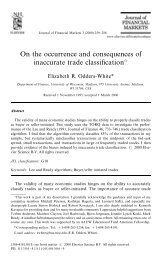A generic framework for Arabic to English machine ... - Acsu Buffalo
A generic framework for Arabic to English machine ... - Acsu Buffalo
A generic framework for Arabic to English machine ... - Acsu Buffalo
You also want an ePaper? Increase the reach of your titles
YUMPU automatically turns print PDFs into web optimized ePapers that Google loves.
2.3. PART OF SPEECH INVENTORY OF THE ARABIC LANGUAGE<br />
A transitive verb is incomplete without a direct object. For example;<br />
Incomplete: hāld yh. ml , Khalid holds.<br />
˘<br />
Complete: <br />
<br />
hāld yh. ml tlāth ktb<br />
˘ ¯ ¯<br />
w h. āswbh ālˇsh ˘ s.y w zhwr , Khalid holds three books, his lap<strong>to</strong>p and flowers.<br />
(3) Ditransitive<br />
A ditransitive verb takes two objects. This can be through an indirect object con-<br />
struction, ֒s. ām ֓a֒t.ā ktāb l֒mr , Essam gave a book <strong>to</strong> Omar<br />
Or double object construction, ֒s. ām ֓a֒t.ā ֒mr ktāb , Essam<br />
gave Omar a book.<br />
2.3.5 Demonstratives<br />
The demonstrative pronouns in <strong>Arabic</strong> include reference <strong>for</strong> the near hd ¯ ā “this”, the<br />
far d ¯ lk “that” and <strong>for</strong> the inbetween d ¯ āk, which has no equivelent in <strong>English</strong>.<br />
2.3.6 Others<br />
This class includes all other types of words not included in the previous categories. It<br />
includes, <strong>for</strong> example, the prepositions, such as mn “from”, ֒lā “on”, fy “in”,<br />
֓ilā “till”. It also includes conjunctions, such as w “and”; determiners such as <br />
āl “the”; relative pronouns, such as āld¯ y “who (masculine)” and ālty “who<br />
(feminine)” and particles, such as ln “Will not” (Khan 2007).<br />
Table 2.22: Particle ‘Lan’<br />
<strong>Arabic</strong> <strong>Arabic</strong> Meaning <strong>English</strong> Translation<br />
<br />
<br />
<br />
<br />
lan yad ¯ haba will not ‘he’ go he will not go<br />
The particle ln is used <strong>to</strong> negate future events. It is used within the imperfect tense<br />
(Versteegh 2001). An example is shown in Table 2.22.<br />
21
















